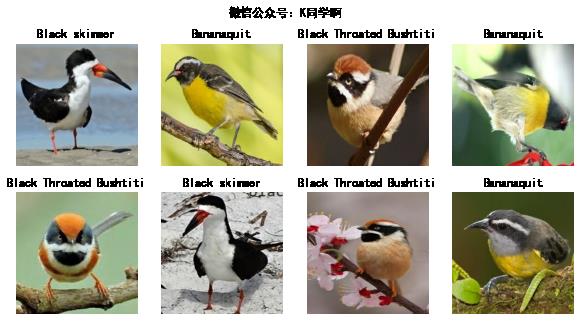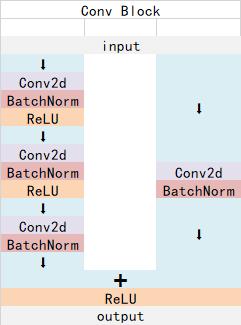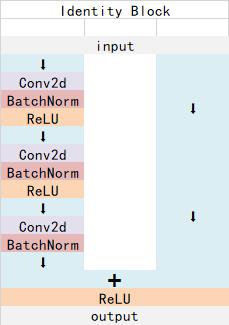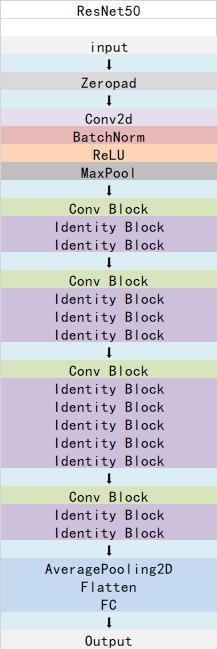深度学习100例 -卷积神经网络(ResNet-50)鸟类识别 | 第8天
Posted K同学啊
tags:
篇首语:本文由小常识网(cha138.com)小编为大家整理,主要介绍了深度学习100例 -卷积神经网络(ResNet-50)鸟类识别 | 第8天相关的知识,希望对你有一定的参考价值。
一、前期工作
本文将采用ResNet-50实现鸟类图片的识别分类
我的环境:
- 语言环境:Python3.6.5
- 编译器:jupyter notebook
- 深度学习环境:TensorFlow2
往期精彩内容:
- 深度学习100例-卷积神经网络(CNN)实现mnist手写数字识别 | 第1天
- 深度学习100例-卷积神经网络(CNN)彩色图片分类 | 第2天
- 深度学习100例-卷积神经网络(CNN)服装图像分类 | 第3天
- 深度学习100例-卷积神经网络(CNN)花朵识别 | 第4天
- 深度学习100例-卷积神经网络(CNN)天气识别 | 第5天
- 深度学习100例-卷积神经网络(VGG-16)识别海贼王草帽一伙 | 第6天
来自专栏: 【深度学习100例】
转载请通过左侧联系方式(电脑端可看)、或者站内私信的方式联系我
1. 设置GPU
如果使用的是CPU可以注释掉这部分的代码。
import tensorflow as tf
gpus = tf.config.list_physical_devices("GPU")
if gpus:
tf.config.experimental.set_memory_growth(gpus[0], True) #设置GPU显存用量按需使用
tf.config.set_visible_devices([gpus[0]],"GPU")
2. 导入数据
import matplotlib.pyplot as plt
# 支持中文
plt.rcParams['font.sans-serif'] = ['SimHei'] # 用来正常显示中文标签
plt.rcParams['axes.unicode_minus'] = False # 用来正常显示负号
import os,PIL
# 设置随机种子尽可能使结果可以重现
import numpy as np
np.random.seed(1)
# 设置随机种子尽可能使结果可以重现
import tensorflow as tf
tf.random.set_seed(1)
from tensorflow import keras
from tensorflow.keras import layers,models
import pathlib
data_dir = "D:/jupyter notebook/DL-100-days/datasets/bird_photos"
data_dir = pathlib.Path(data_dir)
3. 查看数据
image_count = len(list(data_dir.glob('*/*')))
print("图片总数为:",image_count)
图片总数为: 565
二、数据预处理
| 文件夹 | 数量 |
|---|---|
| Bananaquit | 166 张 |
| Black Throated Bushtiti | 111 张 |
| Black skimmer | 122 张 |
| Cockatoo | 166张 |
1. 加载数据
使用image_dataset_from_directory方法将磁盘中的数据加载到tf.data.Dataset中
batch_size = 8
img_height = 224
img_width = 224
TensorFlow版本是2.2.0的同学可能会遇到module 'tensorflow.keras.preprocessing' has no attribute 'image_dataset_from_directory'的报错,升级一下TensorFlow就OK了。
"""
关于image_dataset_from_directory()的详细介绍可以参考文章:https://mtyjkh.blog.csdn.net/article/details/117018789
"""
train_ds = tf.keras.preprocessing.image_dataset_from_directory(
data_dir,
validation_split=0.2,
subset="training",
seed=123,
image_size=(img_height, img_width),
batch_size=batch_size)
Found 565 files belonging to 4 classes.
Using 452 files for training.
"""
关于image_dataset_from_directory()的详细介绍可以参考文章:https://mtyjkh.blog.csdn.net/article/details/117018789
"""
val_ds = tf.keras.preprocessing.image_dataset_from_directory(
data_dir,
validation_split=0.2,
subset="validation",
seed=123,
image_size=(img_height, img_width),
batch_size=batch_size)
Found 565 files belonging to 4 classes.
Using 113 files for validation.
我们可以通过class_names输出数据集的标签。标签将按字母顺序对应于目录名称。
class_names = train_ds.class_names
print(class_names)
['Bananaquit', 'Black Throated Bushtiti', 'Black skimmer', 'Cockatoo']
2. 可视化数据
plt.figure(figsize=(10, 5)) # 图形的宽为10高为5
plt.suptitle("微信公众号:K同学啊")
for images, labels in train_ds.take(1):
for i in range(8):
ax = plt.subplot(2, 4, i + 1)
plt.imshow(images[i].numpy().astype("uint8"))
plt.title(class_names[labels[i]])
plt.axis("off")

plt.imshow(images[1].numpy().astype("uint8"))

3. 再次检查数据
for image_batch, labels_batch in train_ds:
print(image_batch.shape)
print(labels_batch.shape)
break
(8, 224, 224, 3)
(8,)
Image_batch是形状的张量(8, 224, 224, 3)。这是一批形状240x240x3的8张图片(最后一维指的是彩色通道RGB)。Label_batch是形状(8,)的张量,这些标签对应8张图片
4. 配置数据集
- shuffle() : 打乱数据,关于此函数的详细介绍可以参考:https://zhuanlan.zhihu.com/p/42417456
- prefetch() :预取数据,加速运行,其详细介绍可以参考我前两篇文章,里面都有讲解。
- cache() :将数据集缓存到内存当中,加速运行
AUTOTUNE = tf.data.AUTOTUNE
train_ds = train_ds.cache().shuffle(1000).prefetch(buffer_size=AUTOTUNE)
val_ds = val_ds.cache().prefetch(buffer_size=AUTOTUNE)
三、残差网络(ResNet)介绍
1. 残差网络解决了什么
残差网络是为了解决神经网络隐藏层过多时,而引起的网络退化问题。退化(degradation)问题是指:当网络隐藏层变多时,网络的准确度达到饱和然后急剧退化,而且这个退化不是由于过拟合引起的。
拓展: 深度神经网络的“两朵乌云”
- 梯度弥散/爆炸
简单来讲就是网络太深了,会导致模型训练难以收敛。这个问题可以被标准初始化和中间层正规化的方法有效控制。(现阶段知道这么一回事就好了)
- 网络退化
随着网络深度增加,网络的表现先是逐渐增加至饱和,然后迅速下降,这个退化不是由于过拟合引起的。
2. ResNet-50介绍
ResNet-50有两个基本的块,分别名为Conv Block和Identity Block
Conv Block结构:

Identity Block结构:

ResNet-50总体结构:

四、构建ResNet-50网络模型
下面是本文的重点,可以试着按照上面三张图自己构建一下ResNet-50
from keras import layers
from keras.layers import Input,Activation,BatchNormalization,Flatten
from keras.layers import Dense,Conv2D,MaxPooling2D,ZeroPadding2D,AveragePooling2D
from keras.models import Model
def identity_block(input_tensor, kernel_size, filters, stage, block):
filters1, filters2, filters3 = filters
name_base = str(stage) + block + '_identity_block_'
x = Conv2D(filters1, (1, 1), name=name_base + 'conv1')(input_tensor)
x = BatchNormalization(name=name_base + 'bn1')(x)
x = Activation('relu', name=name_base + 'relu1')(x)
x = Conv2D(filters2, kernel_size,padding='same', name=name_base + 'conv2')(x)
x = BatchNormalization(name=name_base + 'bn2')(x)
x = Activation('relu', name=name_base + 'relu2')(x)
x = Conv2D(filters3, (1, 1), name=name_base + 'conv3')(x)
x = BatchNormalization(name=name_base + 'bn3')(x)
x = layers.add([x, input_tensor] ,name=name_base + 'add')
x = Activation('relu', name=name_base + 'relu4')(x)
return x
def conv_block(input_tensor, kernel_size, filters, stage, block, strides=(2, 2)):
filters1, filters2, filters3 = filters
res_name_base = str(stage) + block + '_conv_block_res_'
name_base = str(stage) + block + '_conv_block_'
x = Conv2D(filters1, (1, 1), strides=strides, name=name_base + 'conv1')(input_tensor)
x = BatchNormalization(name=name_base + 'bn1')(x)
x = Activation('relu', name=name_base + 'relu1')(x)
x = Conv2D(filters2, kernel_size, padding='same', name=name_base + 'conv2')(x)
x = BatchNormalization(name=name_base + 'bn2')(x)
x = Activation('relu', name=name_base + 'relu2')(x)
x = Conv2D(filters3, (1, 1), name=name_base + 'conv3')(x)
x = BatchNormalization(name=name_base + 'bn3')(x)
shortcut = Conv2D(filters3, (1, 1), strides=strides, name=res_name_base + 'conv')(input_tensor)
shortcut = BatchNormalization(name=res_name_base + 'bn')(shortcut)
x = layers.add([x, shortcut], name=name_base+'add')
x = Activation('relu', name=name_base+'relu4')(x)
return x
def ResNet50(input_shape=[224,224,3],classes=1000):
img_input = Input(shape=input_shape)
x = ZeroPadding2D((3, 3))(img_input)
x = Conv2D(64, (7, 7), strides=(2, 2), name='conv1')(x)
x = BatchNormalization(name='bn_conv1')(x)
x = Activation('relu')(x)
x = MaxPooling2D((3, 3), strides=(2, 2))(x)
x = conv_block(x, 3, [64, 64, 256], stage=2, block='a', strides=(1, 1))
x = identity_block(x, 3, [64, 64, 256], stage=2, block='b')
x = identity_block(x, 3, [64, 64, 256], stage=2, block='c')
x = conv_block(x, 3, [128, 128, 512], stage=3, block='a')
x = identity_block(x, 3, [128, 128, 512], stage=3, block='b')
x = identity_block(x, 3, [128, 128, 512], stage=3, block='c')
x = identity_block(x, 3, [128, 128, 512], stage=3, block='d')
x = conv_block(x, 3, [256, 256, 1024], stage=4, block='a')
x = identity_block(x, 3, [256, 256, 1024], stage=4, block='b')
x = identity_block(x, 3, [256, 256, 1024], stage=4, block='c')
x = identity_block(x, 3, [256, 256, 1024], stage=4, block='d')
x = identity_block(x, 3, [256, 256, 1024], stage=4, block='e')
x = identity_block(x, 3, [256, 256, 1024], stage=4, block='f')
x = conv_block(x, 3, [512, 512, 2048], stage=5, block='a')
x = identity_block(x, 3, [512, 512, 2048], stage=5, block='b')
x = identity_block(x, 3, [512, 512, 2048], stage=5, block='c')
x = AveragePooling2D((7, 7), name='avg_pool')(x)
x = Flatten()(x)
x = Dense(classes, activation='softmax', name='fc1000')(x)
model = Model(img_input, x, name='resnet50')
# 加载预训练模型
model.load_weights("resnet50_weights_tf_dim_ordering_tf_kernels.h5")
return model
model = ResNet50()
model.summary()
Model: "resnet50"
__________________________________________________________________________________________________
Layer (type) Output Shape Param # Connected to
==================================================================================================
input_1 (InputLayer) [(None, 224, 224, 3) 0
__________________________________________________________________________________________________
zero_padding2d (ZeroPadding2D) (None, 230, 230, 3) 0 input_1[0][0]
__________________________________________________________________________________________________
conv1 (Conv2D) (None, 112, 112, 64) 9472 zero_padding2d[0][0]
__________________________________________________________________________________________________
bn_conv1 (BatchNormalization) (None, 112, 112, 64) 256 conv1[0][0]
__________________________________________________________________________________________________
activation (Activation) (None, 112, 112, 64) 0 bn_conv1[0][0]
__________________________________________________________________________________________________
max_pooling2d (MaxPooling2D) (None, 55, 55, 64) 0 activation[0][0]
__________________________________________________________________________________________________
2a_conv_block_conv1 (Conv2D) (None, 55, 55, 64) 4160 max_pooling2d[0][0]
__________________________________________________________________________________________________
2a_conv_block_bn1 (BatchNormali (None, 55, 55, 64) 256 2a_conv_block_conv1[0][0]
__________________________________________________________________________________________________
2a_conv_block_relu1 (Activation (None, 55, 55, 64) 0 2a_conv_block_bn1[0][0]
__________________________________________________________________________________________________
2a_conv_block_conv2 (Conv2D) (None, 55, 55, 64) 36928 2a_conv_block_relu1[0][0]
__________________________________________________________________________________________________
2a_conv_block_bn2 (BatchNormali (None, 55, 55, 64) 256 2a_conv_block_conv2[0][0]
__________________________________________________________________________________________________
2a_conv_block_relu2 (Activation (None, 55, 55, 64) 0 2a_conv_block_bn2[0][0]
__________________________________________________________________________________________________
2a_conv_block_conv3 (Conv2D) (None, 55, 55, 256) 16640 2a_conv_block_relu2[0][0]
__________________________________________________________________________________________________
2a_conv_block_res_conv (Conv2D) (None, 55, 55, 256) 16640 max_pooling2d[0][0]
__________________________________________________________________________________________________
2a_conv_block_bn3 (BatchNormali (None, 55, 55, 256) 1024 2a_conv_block_conv3[0][0]
__________________________________________________________________________________________________
2a_conv_block_res_bn (BatchNorm (None, 55, 55, 256) 1024 2a_conv_block_res_conv[0][0]
__________________________________________________________________________________________________
2a_conv_block_add (Add) (None, 55, 55, 256) 0 2a_conv_block_bn3[0][0]
2a_conv_block_res_bn[0][0]
__________________________________________________________________________________________________
2a_conv_block_relu4 (Activation (None, 55, 55, 256) 0 2a_conv_block_add[0][0]
__________________________________________________________________________________________________
2b_identity_block_conv1 (Conv2D (None, 55, 55, 64) 16448 2a_conv_block_relu4[0][0]
__________________________________________________________________________________________________
2b_identity_block_bn1 (BatchNor (None, 55, 55, 64) 256 2b_identity_block_conv1[0][0]
=============================================================
此处省略了若干行,此处省略了若干行,此处省略了若干行
=============================================================
__________________________________________________________________________________________________
5c_identity_block_relu2 (Activa (None, 7, 7, 512) 0 5c_identity_block_bn2[0][0]
__________________________________________________________________________________________________
5c_identity_block_conv3 (Conv2D (None, 7, 7, 2048) 1050624 5c_identity_block_relu2[0][0]
__________________________________________________________________________________________________
5c_identity_block_bn3 (BatchNor (None, 7, 7, 2048) 8192 5c_identity_block_conv3[0][0]
__________________________________________________________________________________________________
5c_identity_block_add (Add) (None, 7, 7, 2048) 0 5c_identity_block_bn3[0][0]
5b_identity_block_relu4[0][0]
__________________________________________________________________________________________________
5c_identity_block_relu4 (Activa (None, 7, 7, 2048) 0 5c_identity_block_add[0][0]
__________________________________________________________________________________________________
avg_pool (AveragePooling2D) (None, 1, 1, 2048) 0 5c_identity_block_relu4[0][0]
__________________________________________________________________________________________________
flatten (Flatten) (None, 2048) 0 avg_pool[0][0]
__________________________________________________________________________________________________
fc1000 (Dense) (None, 1000) 2049000 flatten[0][0]
==================================================================================================
Total params: 25,636,712
Trainable params: 25,583,592
Non-trainable params: 53,120
__________________________________________________________________________________________________
五、编译
在准备对模型进行训练之前,还需要再对其进行一些设置。以下内容是在模型的编译步骤中添加的:
- 损失函数(loss):用于衡量模型在训练期间的准确率。
- 优化器(optimizer):决定模型如何根据其看到的数据和自身的损失函数进行更新。
- 指标(metrics):用于监控训练和测试步骤。以下示例使用了准确率,即被正确分类的图像的比率。
# 设置优化器,我这里改变了学习率。
opt = tf.keras.optimizers.Adam(learning_rate=1e-7)
model.compile(optimizer="adam",
loss='sparse_categorical_crossentropy',
metrics=['accuracy'])
六、训练模型
epochs = 10
history = model.fit(
train_ds,
validation_data=val_ds,
epochs=epochs
)
Epoch 1/10
57/57 [==============================] - 12s 86ms/step - loss: 2.4313 - accuracy: 0.6548 - val_loss: 213.7383 - val_accuracy: 0.3186
Epoch 2/10
57/57 [==============================] - 3s 52ms/step - loss: 0.4293 - accuracy: 0.8557 - val_loss: 9.0470 - val_accuracy: 0.2566
Epoch 3/10
57/57 [==============================] - 3s 52ms/step - loss: 0.2309 - accuracy: 0.9183 - val_loss: 1.4181 - val_accuracy: 0.7080
Epoch 4/10
57/57 [==============================] - 3s 53ms/step - loss: 0.1721 - accuracy: 0.9535 - val_loss: 2.5627 - val_accuracy: 0.6726
Epoch 5/10
57/57 [==============================] - 3s 53ms/step - loss: 0.0795 - accuracy: 0.9701 - val_loss: 0.2747 - val_accuracy: 0.8938
Epoch 6/10
57/57 [==============================] - 3s 52ms/step - loss: 0.0435 - accuracy: 0.9899 - val_loss: 0.1483 - val_accuracy: 0.9381
Epoch 7/10
57/57 [==============================] - 3s 52ms/step - loss: 0.0308 - accuracy: 0.9970 - val_loss: 0.1705 - val_accuracy: 0.9381
Epoch 8/10
57/57 [==============================] - 3s 52ms/step - loss: 0.0019 - accuracy: 1.0000 - val_loss: 0.0674 - val_accuracy: 0.9735
Epoch 9/10
57/57 [==============================] - 3s 52ms/step - loss: 8.2391e-04 - accuracy: 1.0000 - val_loss: 0.0720 - val_accuracy: 0.9以上是关于深度学习100例 -卷积神经网络(ResNet-50)鸟类识别 | 第8天的主要内容,如果未能解决你的问题,请参考以下文章